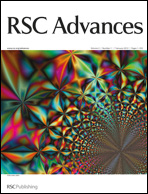This work reports the fabrication of a novel functionalized nanocomposite material capable of reticulation, degradation and the efficient encapsulation of very toxic organic compounds and their degradation by-products. The degradation and encapsulation efficiency was investigated by testing our material on (RS)-O-isopropyl methylphosphonofluoridate (GB), 2,2′-dichlorodiethyl sulfide (HD) and dimethyl methylphosphonate (DMMP). The morphological and morphochemical structure was investigated by means of TEM, SEM and EDX spectrometry. Likewise, the functional structure of the material and the degradation and encapsulation efficiency of toxic compounds and their degradation by-products were elucidated by means of IR spectrometry and gas chromatography coupled with mass spectrometry (GC-MS). It has been found that our fabricated nanocomposite shows a highly structural and functional stability, without counting residual traces of toxic compounds, degradation by-products or molecular fragments coming from degradation samples or from the internal structure of nanocomposite framework. Moreover, experimental evidence proves that our nanocomposite is able to degrade and encapsulate all toxic compounds and all their degradation by-products in less than 16, 5.35, 1 min (in the case of HD, GB and DMMP, respectively), both by catalytic and reticulation processes. We also formulated mechanisms for the degradation and encapsulation of tested toxic compounds and their intermediary by-products in the presence of functionalized substrate. We found that chemically active molecular clusters and Brønsted–Lewis sites coming from the composite framework catalyze the degradation processes. Moreover, we found that grafted functionalities, uncoordinated and unbound metal atoms and metal ion sites play a significant role in reticulation and encapsulation processes.

You have access to this article
 Please wait while we load your content...
Something went wrong. Try again?
Please wait while we load your content...
Something went wrong. Try again?


 Please wait while we load your content...
Please wait while we load your content...